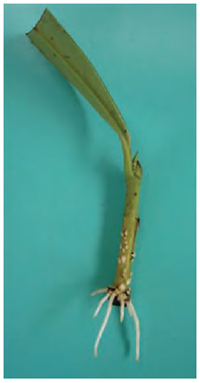Cuttings
ContentStem cuttings can be taken from stems that have attained different stages of maturity. Hardwood cuttings are from pieces of dormant woody stem containing a number of buds, which grow out into shoots when dormancy is broken in spring. The base of the cutting is cut cleanly to expose the cambium tissue from which the adventitious roots will grow (e.g. in rose rootstocks, Forsythia, and many deciduous ornamental shrubs). In Hydrangea and currant the stems show evidence of pre-formed adventitious roots (root-initials), which aid the process of root establishment. Hardwood cuttings are normally taken in late autumn (they are 15–25 cm in length), and are often placed with half their length immersed in a growing medium containing half compost and half sand. A 12-month period is often necessary before the cuttings can be lifted. Semi-ripe cuttings are taken from stems that are just becoming woody. They are normally taken from mid-summer to early autumn. Most cuttings of this kind are 5–10 cm long. Rooting in a sand/compost mixture may be achieved in cold frames or, more quickly, in a heated structure at about 18°C. Eleagnus (Oleaster) will root only if heat is provided. Many shrub and tree species, e.g. holly and conifers, are propagated as ‘heeled’ cuttings. Here, the semi-ripe cutting is taken in such a way that a one centimetre sliver of last year’s wood (the heel) is still attached. The heel cambium facilitates root formation and, hence, easier establishment of cuttings. Stems without a woody nature are used for the propagation of plants such as Fuchsia, Pelargonium and Chrysanthemum. These are called softwood cuttings (see Figure 12.3), and they are most often taken in late spring and early summer. The area of leaf on these cuttings should be kept to a
Automatic misting employs a switch attached to a sensitive device used for assessing the evaporation rate from the leaves. The cool conditions favouring the survival of the aerial parts of the cutting, however, do not encourage the division of cells in the cambium area of the root initials. The temperature in the rooting medium may be increased with electric cables producing bottom heat . These special conditions for the success of cuttings are provided in propagation benches in a greenhouse. Leaf cuttings are also susceptible to wilting before the essential roots have been formed, and will benefit from mist, provided the wet conditions do not encourage rotting of the plant material. Leaves of plants such as Begonia, Streptocarpus and Sansevieria are divided into pieces from which small plantlets are initiated, while leaves plus petioles are used for Saintpaulia propagation. Nursery stock species, e.g. Camellia and Rhododendron, require a complete leaf and associated axillary bud in a leaf-bud cutting. Root cuttings may be an option when other methods are not seen to succeed. This method is used for species such as Phlox paniculata and Anchusa azurea (alkanet). Roots about a centimetre in thickness are taken in winter and cut into 5 cm lengths. They are inserted vertically into a sand/compost mixture in most species, but thinner-rooted species such as Phlox are placed horizontally. It is important that root cuttings are not, inadvertently, placed upside-down, as this will prevent establishment. |





